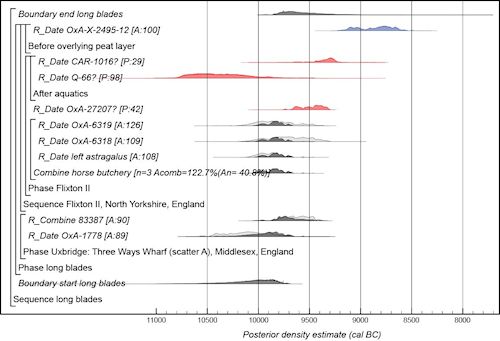
A summary of the currency of different assemblage types is shown in Figure 8.

It is clear (98% probable) that Long Blades appeared before all other types considered in this synthesis. It is less clear whether their use overlapped with early Mesolithic types. On the basis of the model defined in Figures 2–7, it is 80% probable that they continued in use after the first appearance of Star Carr-type assemblages, but the overlap (if it occurred) probably amounts to no more than a few centuries (Figure 8).
The transition between Long Blades and the early Mesolithic was recently considered by Conneller and Higham (2015, fig. 2) and a gap between the two industries was posited. This gap has been closed in the recent analysis, partly on the basis of new dates from Flixton and Star Carr, partly as a result of different measures of selectivity in determining association between dates and archaeological events taken by the two projects, and partly because the use of formal chronological modelling in this study allows us to quantify the uncertainties inherent in our small samples of dated sites.

An alternative model was constructed to explore the plausibility of the posited gap. This is of the form shown in Figure 2, with an alternative component relating to long blades shown in Figure 9. In this reading we interpret all the dates on horse bone from Flixton II as the result of a single hunt, and exclude the radiocarbon date on a waterlogged twig from the peat in which the bones were found and two measurements on bulk fractions of the same peat as not securely related to the anthropogenic event. This model also has good overall agreement (Amodel: 64). It suggests that Long Blades first appeared in 11,335–9675 cal BC (95% probability; start long blades; Figure 9), probably in 10,320–9765 cal BC (68% probability), and ceased to be used in 9985–8465 cal BC (95% probability; end long blades; Figure 9), probably in 9825–9350 cal BC (68% probability). It suggests that it is 61% probable that the use of long blades ended before the start of Star Carr-type flint (or, conversely, that it is 39% probable that their use overlapped). Within the resolution of the data currently available, both interpretations clearly remain open. The balance of probability between them very much depends on our reading of the accuracy of the various measurements on horse bones from Flixton II (Table 1 and Table 2), and on our understanding of the relationship between the sediment unit in which the bones were found and the bones themselves.
Whatever the relationship between the final use of Long Blades and the introduction of Star Carr-type assemblages, the model shown in Figure 2 suggests that it is 95% probable that Deepcar-type assemblages first appeared after the first Star Carr-type assemblages, but it is 100% probable that their use overlapped in time. Deepcar assemblages probably appeared around half a millennium after the first Star Carr-type assemblages. This finding echoes that of Reynier (2005), and it is interesting that despite a new and comparatively early date for Deepcar-type assemblages from the Eton Rowing Lake (OxA-14088; Figure 5), this difference is still present.
After the appearance of Deepcar-type assemblages (88% probable), came the first basally modified assemblages. These assemblages certainly overlapped with the use of Star Carr-type assemblages and Deepcar-type assemblages (100% probable), at least in certain areas of the country.
Scalene triangles appeared next (98% probable). Their use certainly overlapped with basally modified assemblages (100% probable), and probably overlapped Deepcar-type assemblages (75% probable) and possibly Star Carr types as well (54% probable). These overlaps, if they occurred, were probably confined to a few centuries around 8000 cal BC (Figure 8).
Internet Archaeology is an open access journal based in the Department of Archaeology, University of York. Except where otherwise noted, content from this work may be used under the terms of the Creative Commons Attribution 3.0 (CC BY) Unported licence, which permits unrestricted use, distribution, and reproduction in any medium, provided that attribution to the author(s), the title of the work, the Internet Archaeology journal and the relevant URL/DOI are given.
Terms and Conditions | Legal Statements | Privacy Policy | Cookies Policy | Citing Internet Archaeology
Internet Archaeology content is preserved for the long term with the Archaeology Data Service. Help sustain and support open access publication by donating to our Open Access Archaeology Fund.